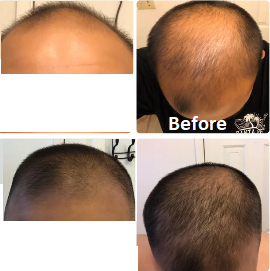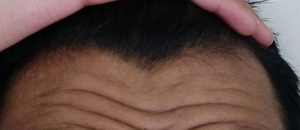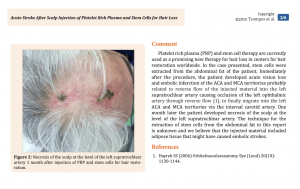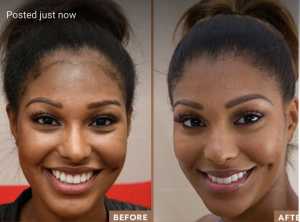So I’m not sure if I should try to prevent the inevitable. At 23 and with bald ancestors, I’m not sure any treatment will do more than just delay the hair loss. Is it worth attempting to save my hairline or will it all be in vain? Also how much will it cost me to more or less?
let’s assume that the burn is in the front and top of the head. A balloon is then placed in the crown to expanded in the scalp over a couple of months. Each week, about two times, fluid is injected into a ‘port’ on the balloon. With each injection, the balloon expands until it is stretched enough with enough redundancy to cover the burned areas. Then the burned scar is removed and the new scalp is advanced forward. I have been involved in a number of these challenging cases and the results are very rewarding. I have seen fully half of the scalp burned and treated successfully this way, sometimes with added hair transplants for fine tuning the process.
Surprisingly my hair transplanted grafts started to immediately grow after about two weeks. I still had crust on my head from the transplant and the hair started to peek through. I was doing my research intensively before that and haven’t found one with almost instant results as i did. I was told from my doctor that it could take up to a year to see the full effect. It definitely met my expectations but the other non transplanted hair isn’t immune to DHT so this could lead to dissatisfaction again in a couple of years.
Most hair appears to grow immediately, but falls out in 2-4 weeks. About 1 in 20 people get instant growth that continues from the day the transplant was done. Most are somewhere between the two examples I discussed above. As hair loss is a progressive process, you should consider another FUE and if you are satisfied with your surgeon, go back and see that surgeon for an opinion about another FUE.
If you have someone who is elder and needs help, here is an article sent to me to address this.
Long-Distance Care: Tips On How To Ensure A Loved One Is Healthy And Happy From Afar
Photo via Pixabay by ArtWithTammy
When you live far away from a senior loved one, it can be difficult to ensure they receive the care they need and that their emotional needs are met. For many people, trying to plan for a family member from afar is stressful and comes with feelings of guilt because they can’t be there in person.
Fortunately, there are several simple things you can do to help make sure your senior loved one is well taken care of no matter where you live. Nowadays, technology makes it easier than ever to stay informed and maintain a presence in your family members’ lives, even from afar. For seniors who have health issues, mobility issues, or are ready to downsize their home so that they can age-in-place, this is imperative and can help you have more control over the situation.
Here are some of the best ways you can help your loved one.
Communicate with your family
If your family is scattered across the country, it may be hard to pin everyone down to share information and make decisions that will affect your loved one. Keep up communication as much as possible through email or by using an app like Skype so you can talk and see one another at the same time. Set up meetings to discuss any upcoming events or planning that needs to be done. Keeping everyone on the same page will ensure that the bulk of the work won’t fall on any one person’s shoulders.
Get organized…
I read a lot of your comments and the article on Mature hairlines you usually share. Would it be possible for you to check the situation with my hair? I pass the wrinkled forehead test, but my temples are really high.
Here is my forehead wrinkled:
This is a maturing hairline. It will go up much further still with some more corner recession until the entire hairline is one finger breadth above the highest crease in the center and a V-Shape as the hairline moves outward.
This is a disturbing article because it put a new risk for PRP, although very a very remote risk. The doctor may have entered one of the vessels that communicated through the skull into the brain. Although these connections are usually small, we have known that such connections exist. The post-treatment of necrosis also indicates that possibly too much PRP was injected into the scalp, enough to cause the necrosis, again an unusual happening. The stroke may have been related to the use of fat cells in the mixture with the PRP but the connections from the scalp to the brain are clearly known anatomical vessels. Two unusual complications, both rare, suggest that there is more to what happened than just a standard PRP treatment. This was published in the Journal of Neurology and Stroke (Click to enlarge the page)
I’ve taken fin for 4 years, thinking about getting a hair transplant soon.
But lately I’ve noticed some sexual side effects and am thinking about getting off it. Would it be possible to quit after the transplant or would that make my hair look really bad?
Hair loss is progressive, and you must continue taking the finasteride to slow down the progression of the genetic balding that caused the hair loss in the first place, that is, unless you are having side effects.
Saw this story and Im honestly worried about this the most. My mental state is very valuable to me. Can anyone give some insight?
There are reports in a few men taking finasteride that there are central nervous system problems with this drug. If that happens to you, you are best off stopping the drug and these symptoms go away.
The average Caucasian male loses 100 hairs per day at the age of 21 and regrows that same number of hairs. More than that is shedding.
Basically from what I’ve seen discussed, when people get hair transplants, they move hair from the sides/back of head to the top. This sometimes leads to scarring, so what people do is the keep the sides/back a bit longer to conceal it. If i were to get a hair transplant would I still be able to get skinfade haircuts like this or would I be required to keep the sides/back long due to scarring or any other reason
The answer to that question is: (1) depends upon your donor density, the higher it is, the less the problem, (2) it depends upon hair thickness, the higher it is, the less the problem, (3) it depends upon how many FUE grafts were taken and transplanted and (4) it depends upon your hair length, the longer it is, the less will be the problem.
ive been on Fin for a couple months with great regrowth. 1 month ago i started noticing some scalp inflammation, and it got really bad last week. Although i couldnt see alot of hairshedding, some parts of my hair took a big hit, and thinned out really fast. Anyone know how long it will take to regrow after ive adressed the inflammation?
See your doctor. This is important to understand and get the right advice.






